Had my first reload squib the other day. Running .38 Special with 4.0 grains of HP-38 and Everglades 158 grain plated bullets. I've ran this load perfectly fine a few times now without any issues. This time, however, I had to switched to Federal primers -- I usually pick up Winchester primers but Cabela's was out of stock the last time.
During the session I noticed one that felt particularly weak and I made it a point to check the barrel immediately. ~25 rounds later same thing, but this time I had a squib flush with the muzzle. (Was a massive pain to remove by the way... Tried to pull it out but no go, ended up essentially hollowing it out before forcing it all the way back to the forcing cone, 4 inches...)
Now, I know everyone is going to say it was the charge... I reload on a single stage press and weigh every single charge manually. Zero distractions in the room. I visually confirm powder level for every piece of brass in the tray before moving over to seating bullets. Blowing up a gun in my hand with a double charge makes me extremely paranoid.
Decapping and pocket cleaning occurred immediately before priming so I'm not even sure how it would a flash hole obstruction...
Is it possible that I just got a bad batch of primers? I have 50 left in that box and I don't even want to use them after the ordeal. Already planning to do a post mortem on the 12 or so I have left in that box of 50...
During the session I noticed one that felt particularly weak and I made it a point to check the barrel immediately. ~25 rounds later same thing, but this time I had a squib flush with the muzzle. (Was a massive pain to remove by the way... Tried to pull it out but no go, ended up essentially hollowing it out before forcing it all the way back to the forcing cone, 4 inches...)
Now, I know everyone is going to say it was the charge... I reload on a single stage press and weigh every single charge manually. Zero distractions in the room. I visually confirm powder level for every piece of brass in the tray before moving over to seating bullets. Blowing up a gun in my hand with a double charge makes me extremely paranoid.
Decapping and pocket cleaning occurred immediately before priming so I'm not even sure how it would a flash hole obstruction...
Is it possible that I just got a bad batch of primers? I have 50 left in that box and I don't even want to use them after the ordeal. Already planning to do a post mortem on the 12 or so I have left in that box of 50...


